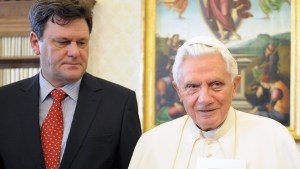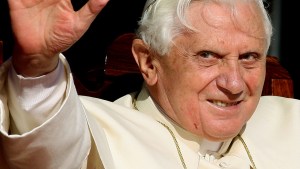It’s funny the things you don’t remember. It had been at least a decade since I had read the first volume of Pope Benedict XVI’s Jesus of Nazareth series. (Or perhaps I should say, Joseph Ratzinger’s, since the pope made clear that this writing was not issued as papal magisterium, but private theology.) So when I plucked it off the shelf and started reading it again, I was amazed at the gems I had underlined and starred at the time—because I’m the sort of Philistine who writes in his books—that I had no recollection of. It was like reading them for the first time. And, by chance or Providence, I ran into a marvelous insight just in time for today’s feast.
Benedict begins his first volume of his examination of Jesus’ life not with the infancy, but with the inauguration of Jesus’ public ministry: His baptism in the Jordan.
Benedict discusses the background context for the scene—the practice of ritual washings in Judaism, their connection to forgiveness of sin, and the unique nature of John the Baptist’s ministry—and takes up the common question, “Why would Jesus need to be baptized if He is sinless?”
In answering that, he draws out a connection I had never considered before.
In our understanding of the Christian sacrament of baptism, Benedict notes, entering into the waters evokes both life and death.
It calls to mind death because “the ancient mind perceived the ocean as a permanent threat to the cosmos, to the earth; it was the primeval flood that might submerge all life.” (p. 15-16)
But, Benedict adds, “the flowing waters of the river are above all a symbol of life,” so that “immersion in the water is about purification, about liberation from the filth of the past that burdens and distorts life—it is about beginning again, and that means it is about death and resurrection, about starting life over again anew.” (p. 16)
Christian baptism has had this meaning developed over centuries, but Jesus’ baptism in the Jordan “implicitly contains” this idea, and points toward it. By Jesus undergoing a ritual for sinners, He is giving a “Yes to the entire will of God” which “also expresses solidarity with men, who have incurred guilt but yearn for righteousness.” (p. 17)
This is the first time in which Jesus stands in our place, the innocent and just man in the place of sinful humanity, taking on to Himself what we must undergo.
This act at the beginning of Jesus’ mission then looks forward to its culmination in His death and resurrection, His going into the tomb and rising to new life. Thus, in the light of these salvific events, Benedict writes, “the Christian people realized what happened. Jesus loaded the burden of all mankind’s guilt upon his shoulders: he bore it down into the depths of the Jordan. He inaugurated his public activity by stepping into the place of sinners. His inaugural gesture was an anticipation of the Cross.” (p. 18)
Benedict ties the thread by concluding “this also explains why, in his own discourses, Jesus uses the word baptism to refer to his death.” (p. 18)
We see this connection reflected in the shape of the liturgical year. Today’s feast, the Baptism of the Lord, marks the end of the Christmas season, the time of commemorating Christ’s coming into the world. Yet it also points to the end of the Lenten season, the beginning of His Passion and the holy events of the Easter Triduum. His life foretells His death—and not only His death, but also His resurrection. The end of Christmas already has us looking toward Holy Week.



